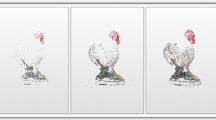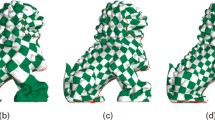Abstract
We present AtelierM++, a new interactive marbling image rendering system which allows artists to create marbling textures with real-time visual feedback on mega-pixel sized images. Marbling is a method of aqueous surface design, which can produce patterns similar to marble or other stone, hence the name. The system is based on the physical model of the traditional marbling process. We simulate real marbling by solving the Navier-Stokes equations on the graphics processing unit. We employ a third-order accurate but fast Unsplit semi-Lagragian Constrained Interpolation Profile method to reduce the numerical dissipation while retaining the stability. To simulate very sharp interface lines among different paints, a simple yet effective transformation function is applied to the paint concentrations. Several intuitive interfaces are implemented to provide flexible control for users. Extensive experimental results are shown to demonstrate both the effectiveness and efficiency of the proposed approach.









Similar content being viewed by others
References
Acar R (2007) Level set driven flows. ACM Trans Graph 26(4), article 15
Acar R, Boulanger P (2006) Digital marbling: a multiscale fluid model. IEEE Trans Vis Comput Graph 12(4):600–614
Akgun BT (2004) The digital art of marbled paper. Leonardo 37(1):49–51
Blythe D (2006) The Direct3D 10 system. In: Proc ACM SIGGRAPH ’06. ACM, New York, pp 724–734
Bolz J, Farmer I, Grinspun E, Schröder P (2003) Sparse matrix solvers on the GPU: conjugate gradients and multigrid. ACM Trans Graph 22(3):917–924
Cabral B, Leedom L (1993) Imaging vector fields using line integral convolution. In: Proc ACM SIGGRAPH ’93. ACM, New York, pp 263–270
Fan Z, Qiu F, Kaufman AE (2008) Zippy: a framework for computation and visualization on a GPU cluster. Comput Graph Forum (EUROGRAPHICS ’08) 27(2):341–350
Goodnight N, Woolley C, Lewn G, Luebke D, Humphreys G (2003) A multigrid solver for boundary value problems using programmable graphics hardware. In: Proc EUROGRAPHICS/SIGGRAPH workshop graphics hardware. EUROGRAPHICS, Geneve, pp 102–111
Harris MJ (2004) Fast fluid dynamics simulation on the GPU. GPU Gems 38:637–665
Harris M, Sengupta S, Owens JD (2007) Parallel prefix sum (scan) with CUDA. GPU Gems 3 39:851–876
Jin X, Chen S, Mao X (2007) Computer-generated marbling textures: a GPU-based design system. IEEE Comput Graph Appl 27(2):78–84
Kim B, Liu Y, Llammas I, Rossignac J (2007) Advections with significantly reduced dissipation of diffusion. IEEE Trans Vis Comput Graph 13(1):135–144
Kim D, Song OY, Ko HS (2008) A semi-Lagrangian CIP fluid solver without dimensional splitting. Comput Graph Forum (EUROGRAPHICS ’08) 27(2):467–475
Mao X, Suzuki T, Imamiya A (2003) AtelierM: a physically based interactive system for creating traditional marbling textures. In: Proc 1st international conf. computer graphics and interactive techniques in Australasia and South East Asia (GRAPHITE ’03). ACM, New York, pp 79–86
Maurer-Mathison D (1999) The ultimate marbling handbook: a guide to basic and advanced techniques for marbling paper and fabric. Watson-Guptill, New York
Morimoto Y, Tanaka M, Tsuruno R, Tomimatsu K (2007) Visualization of dyeing based on diffusion and adsorption theories. In: Proc 15th Pacific conference on computer graphics and applications (PG ’07). IEEE, Washington, DC, pp 57–64
NVIDIA Corp (2008) NVIDIA CUDA compute unified device architecture programming guide, version 2.1. http://developer.nvidia.com/cuda
Orzan A, Bousseau A, Winnemöller H, Barla P, Thollot J, Salesin D (2008) Diffusion curves: a vector representation for smooth shaded images. ACM Trans Graph 27(3), article 92
Packer R (1999) Just what is multimedia, anyway? IEEE Multimed 6(1):11–13
Perlin K (1985) An image synthesizer. In: Proc ACM SIGGRAPH ’85. ACM, New York, pp 287–296
Selle A, Fedkiw R, Kim B, Liu Y, Rossignac J (2008) An unconditionally stable MacCormack method. J Sci Comput 35(2–3):350–371
Song OY, Shin H, Ko HS (2005) Stable but nondissipative water. ACM Trans Graph 24(1):81–97
Stam J (1999) Stable fluids. In: Proc ACM SIGGRAPH ’97. ACM, New York, pp 121–128
Suzuki T, Mao X, Imamiya A (2001) Simulating marbling with computer graphics. In: Proc IASTED international conf. visualization, imaging, and imaging processing. IASTED, Calgary, pp 208–213
Weiskopf D (2004) Dye advection without the blur: a level-set approach for texture. Comput Graph Forum (EUROGRAPHICS ’04) 23(3):479–488
Wikimedia Foundation, Inc (2008) Sinc filter. http://en.wikipedia.org/wiki/Sinc_filter
Xu J, Mao X, Jin X (2008) Nondissipative marbling. IEEE Comput Graph Appl 28(2):35–43
Zhao H, Jin X, Shen J, Mao X, Feng J (2008) Real-time feature-aware video abstraction. Vis Comput (CGI ’08) 24(7–9):727–734
Acknowledgements
The authors are especially grateful to our anonymous reviewers for their insightful and constructive comments. Many thanks also to Xiaoyan Luo and Yandan Zhao for their kind help in presenting the manuscript. The left pictures in Fig. 1 and the leftmost picture in Fig. 7 are downloaded from http:/quilting.about.com/. This work was supported by the Science and Technology Plan of Zhejiang Province (Grant No. 2008C24008), the National Key Basic Research Foundation of China (Grant No. 2009CB320801), the National Natural Science Foundation of China (Grant No. 60833007), and the Key Technology R&D Program (Grant No. 2007BAH11B03).
Author information
Authors and Affiliations
Corresponding author
Rights and permissions
About this article
Cite this article
Zhao, H., Jin, X., Lu, S. et al. AtelierM++: a fast and accurate marbling system. Multimed Tools Appl 44, 187–203 (2009). https://doi.org/10.1007/s11042-009-0290-z
Published:
Issue Date:
DOI: https://doi.org/10.1007/s11042-009-0290-z




